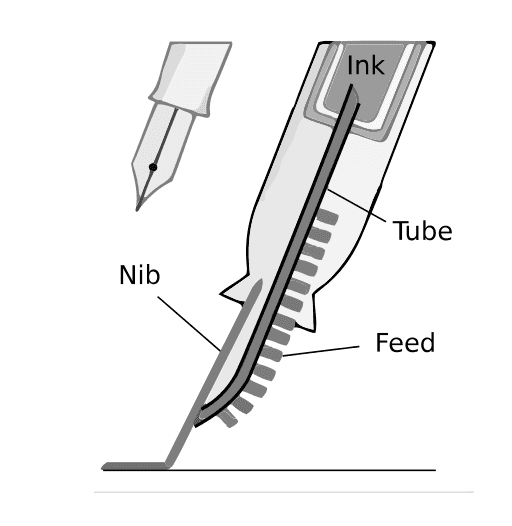How to Store a Fountain Pen
Storing a fountain pen correctly is an essential part of maintenance and care. Improper storage can cause leakage, or damage to the tube, feeder, and/or nib. Throughout this article we provide several solutions as to how to store a fountain pen, whether it be for home, office, or during travel. Below, we have provided a decision tree outlining how the environment and the length of usage can affect your storage options.
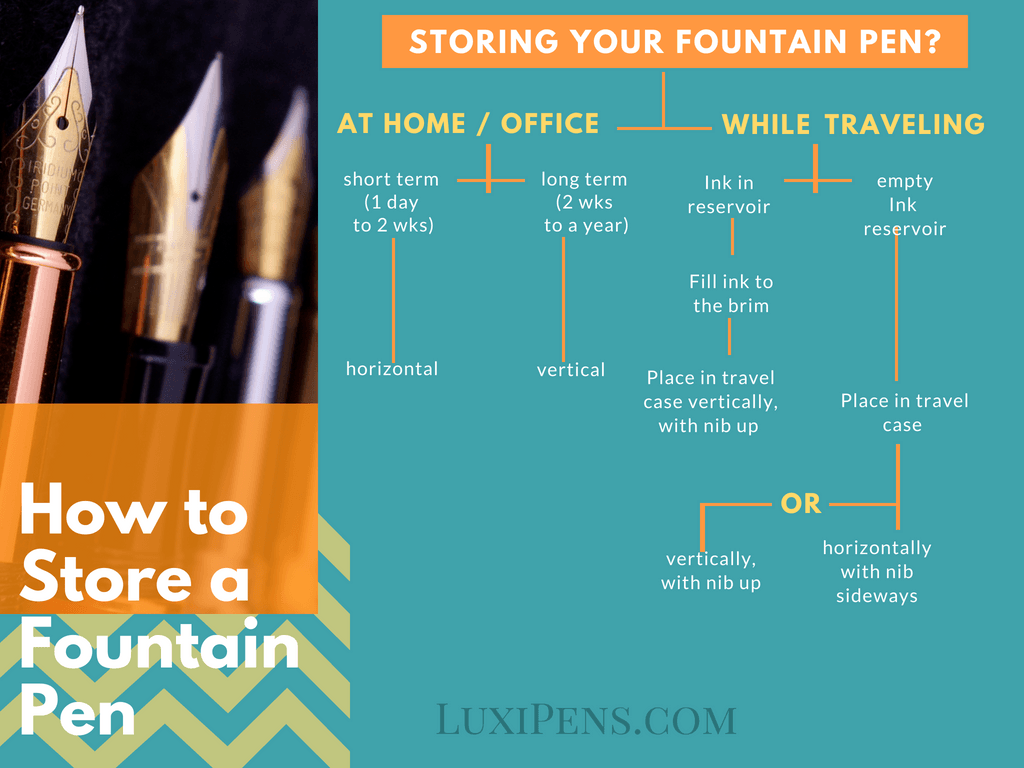
As you can see from the decision tree, is it best to store a fountain pen
in a cool, dry place, away from direct sunlight, and with the pen in either a vertical position, with the nib pointing up, or a horizontal position, with the nib pointing sideways.
When traveling, it is best to store a fountain pen in a traveling case with the ink reservoir either emptied or filled to the brim.
The recommended length of time for storing a fountain pen depends on the amount of ink in the reservoir and its position. The chart below provides the recommended length of storage for each position and ink level.
How to Store a Fountain Pen: Recommended Length of Time
Note: Mobile devices - scroll right to see entire table.
Position of Storage | Length of Storage |
|---|---|
Horizontal without ink | Up to a year |
Horizontal with ink | No more than two weeks |
Vertical without ink | Up to a year |
Vertical with ink | No more than a month |
Fountain Pen Storage Basics
Before storing your fountain pen, it is important to clean the nib of any ink. This is to prevent ink from drying on the nib and/or pooling inside the cap, ultimately ‘gunking’ up the nib. If the fountain pen will be used within the next few days, it’s ink reservoir does not need to be emptied. The ink reservoir should only be emptied if the fountain pen will be stored for more than a month.
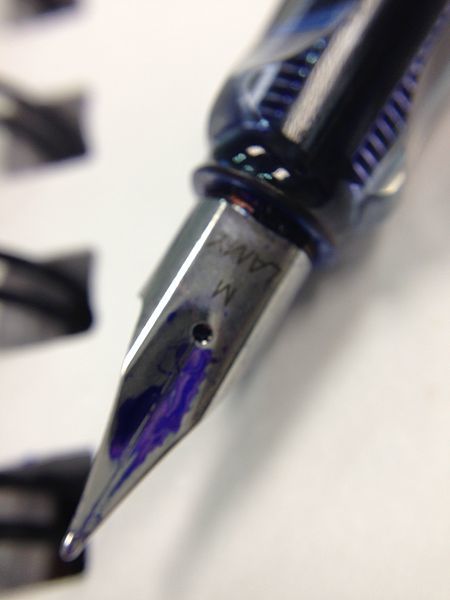
A Lamy fountain pen with blue ink on the nib. Photo By Saraclaroscuro
After a fountain pen’s nib has been cleaned, it should be capped. Capping, also known as posting, is placing the cap over the nib, until the cap can go down no further. Some fountain pens gently click once the cap has been pushed all the way down. This will protect the nib from being damaged and will prevent the ink inside the fountain pen from drying.
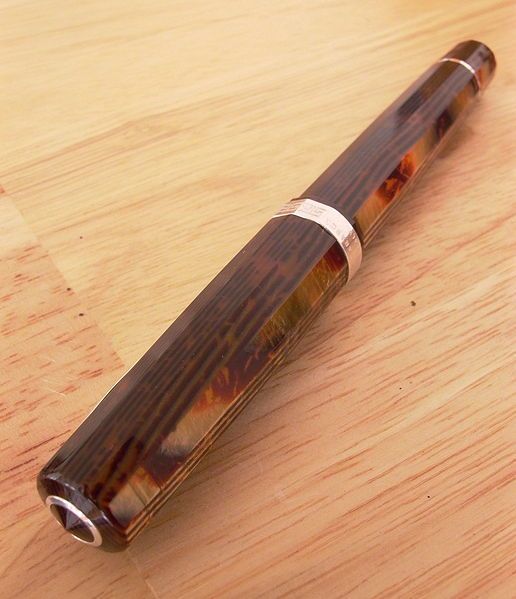
A picture of a capped Arco fountain pen - Photo by Helian
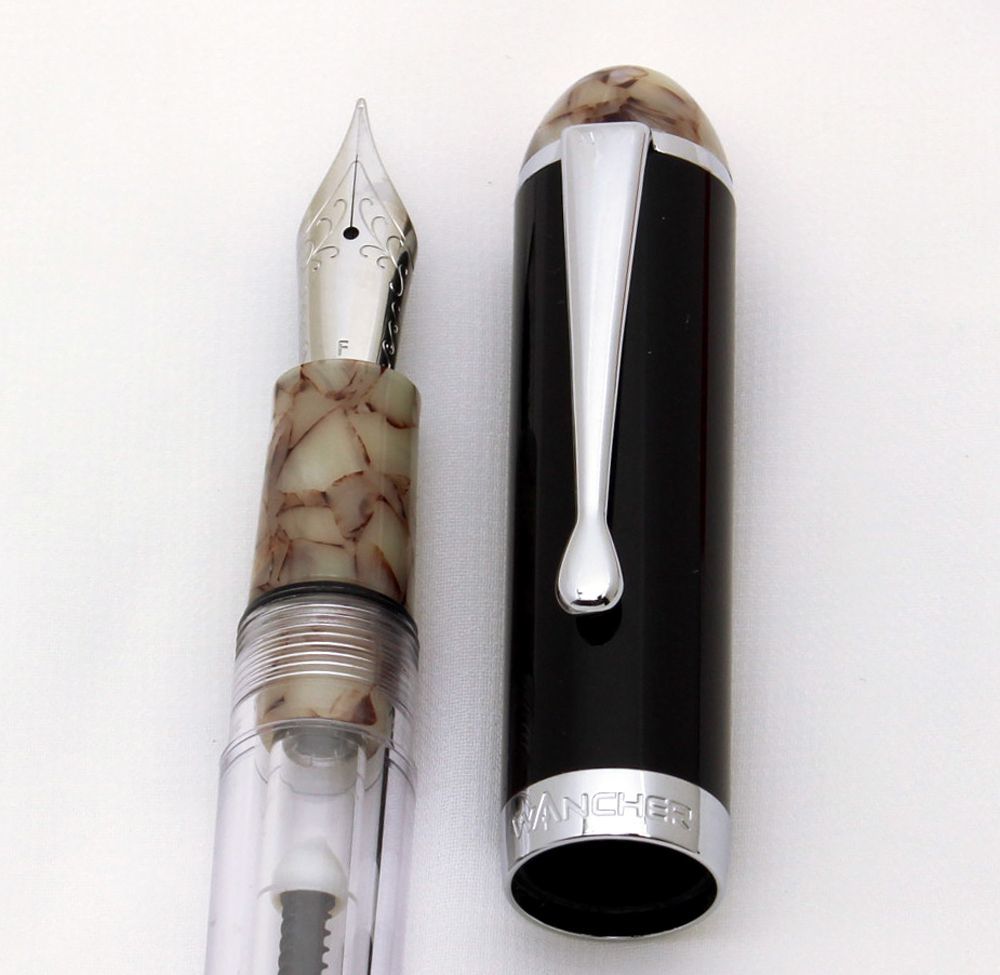
A picture of an uncapped Crystal light smoke topaz fountain pen. Photo by Baogao1616
Fountain Pen Storage Basics: Nib Up or Down
The goal of storing your fountain pen is to protect the internal mechanisms, to keep the ink from drying, and to prevent ink from pooling in the feeder or the nib. The first step is to decide in which position it will be stored.
The two recommended positions are: vertically, with the nib facing upwards, and horizontally, with the nib facing sideways. A fountain pen should never be stored vertically with the nib facing downwards. Gravity will pull the ink towards the feeder and nib, causing it to pool in the feeder, clog the nib, and leak through the nib into the cap. Leakage and clogging, will not only create messes for the user, but will also damage the internal mechanisms of the fountain pen.While the position, ultimately, depends on user preference, there are several factors to consider before deciding. If the fountain pen is emptied of ink, either position is a viable option. However, if your fountain pen’s cartridges are filled with ink, both positions provide different advantages. This is because a fountain pen utilizes capillary action, the movement of liquid.
To learn more about how capillary action functions in a fountain pen, please read our article: "How Does a Fountain Pen Work."
When a pen is filled with ink, the horizontal positions keeps the nib wet, but prevents gravity from pulling all the ink into the feeder, nib, and cap. This lowers the risk of leakage, while allowing the pen to write immediately after being taken out of storage. However, since this position keeps the nib wet, it can lead to the ink pooling into feeder and nib and/or drying.
When a fountain pen is filled with ink, the vertical position allows gravity to pull the ink towards the back of the pen, away from the nib and cap. This prevents leakages as well as damaged or clogged feeders and nibs, but it affects how the pen writes immediately after storage. Since the ink pools towards the back, it may take a second or two for it to refill the nib and write.
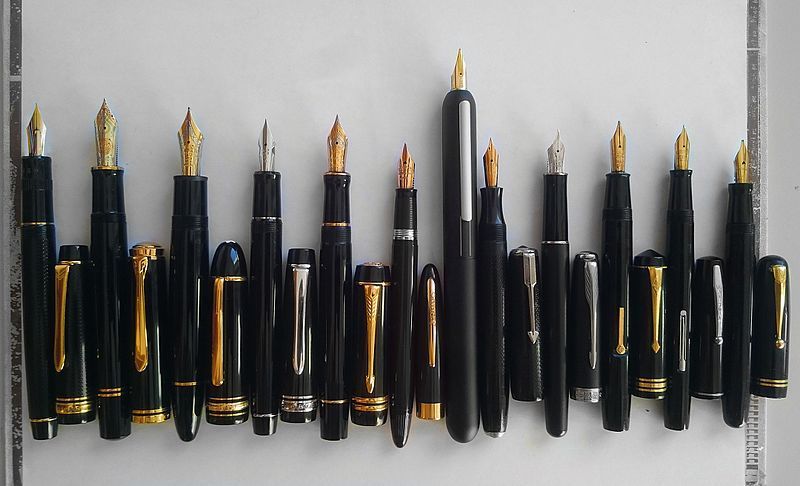
Vertical Fountain pens with their nibs facing upwards, Photo by By Ilkin Santak
Fountain Pen Storage Basics: Environment
When storing your fountain pens, it is important to consider the location and environment. Fountain pens are sensitive to sunlight, heat, and humidity. It is vital to select a location that has minimum exposure to these elements. When a pen heats up, either by being placed in direct sunlight or in an overly warm location, the air inside the ink cartridges will expand, causing the pen to leak. Fountain pens should be stored in a cool, dry place, away from direct sunlight and humidity.
It is beneficial to have a designated place for your fountain pens, whether that be in your office, bedroom, or living room. This allows you to regulate the temperature and atmosphere. It also prevents lost pens, damaged nibs, and dry or leaking ink.
Flying with a Fountain Pen
There is a difference in storage methods when using a fountain pen in a stable environment, like an office, and when flying with a fountain pen. Flying is one of the most stressful methods of travel for a pen. The changes in cabin pressure expands the air trapped inside the ink reservoir, pushing ink out of the cartridge through the nib, causing a leak.
The highest risk of leakage is during takeoff because planes don’t pressurize until 6000 ft elevation. This is when the air in the fountain pen is mostly likely to expand and force the ink out. Once the plane has stabilized at 6000 ft, the fountain pen can be used without fear of leakage. However, keep in mind that if the pen is used while flying, there will be less ink in the cartridge, running the risk of an air pocket developing during landing.
How to Travel with Fountain Pens: Ways to Avoid Leaks
- 1Completely empty the reservoir of ink and clean the fountain pen before travel.
- 2Fill the ink reservoir to the very top. A full ink reservoir has no air to expand, preventing leakage.
- 3If you are going to fill your fountain pen to the top, it should be stored in a vertical position, with the nib facing upwards, so the ink pools towards the back of the fountain pen and not near the nib.
- 4Keep the fountain pen(s) in a separate bag from your other items, so, if a leak occurs, it will not damage your belongings.
- 5A common suggestion is to place your fountain pens in a plastic bag, but this runs the risk of damaging the body.
- 6The better suggestion is to use a fountain pen travel case.
This post contains affiliate links. See our disclosure page for more information.
Fountain Pen Cases
Fountain pen cases fall into four generic categories: fountain pen storage boxes, fountain pen display cases, fountain pen travel cases, and leather fountain pen cases. The storage boxes and display cases are best for office storage while the travel case and the leather fountain pen case are best for traveling. Ultimately, all the cases that will be discussed can be used to store your pens, but the choice is up to your preference, price range, and need.
Fountain Pen Storage Box
Fountain pen storage boxes are often horizontal, rectangular boxes (similar in designed to a dresser drawer). They are lined with suede, felt, or cotton flannel to protect the outside of the pen. Be careful storing fountain pens in storage boxes lined with velvet. The material has nylon strands woven into the fabric that can damage the body of the pen. Boxes with plastic dividers can also harm the body of the fountain pen.
Fountain Pen Display Cases
A fountain pen display case can look like a storage box, or it can be a vertical box with a glass panel in the lid. These cases are a fantastic way to show off your vast fountain pen collection. Because of the glass panel, it is vital to avoid storing the case in an area that is in direct sunlight. If you don’t, the glass will act like a magnifier, focusing the light on the fountain pens, running the risk of damaging your pens or causing them to leak.
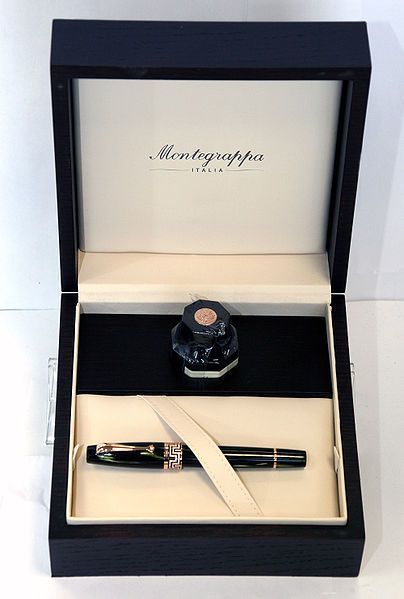
Fountain Pen Display case, Photo by Vadim Zhuravlev [Public Domain]
Fountain Pen Travel Case
A fountain pen travel case can be leather and small, but it also be made from plastic or wood. The purpose of these cases is to protect the pens while traveling, so they are not always the prettiest or most decorative containers. However, in this case, practicality should trump attractive aesthetic. These cases often have suede or felt lining and have straps that lock the pens in place, ensuring the pens do not move around during travel. They are also small and can fit in a back pocket or a travel bag.
Leather Fountain Pen Cases
A leather fountain pen case is a subset of the larger category of travel cases. These expensive cases are preferred by fountain pen owners because they are nicer looking than most travel cases and suggest a higher form of lifestyle. They are lined with soft cloth to prevent damage to your pens during travel. The leather cases can fit in a back pocket or slip into a travel bag.
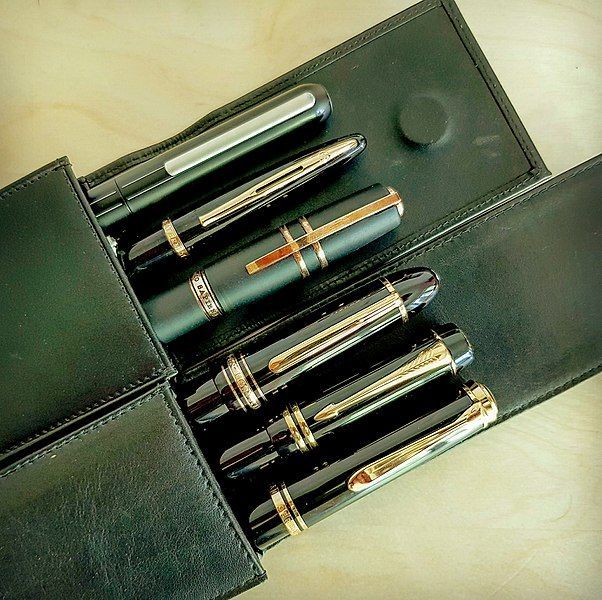
A leather fountain pen case containing a Lamy Dialog 3, Waterman Carene, Visconti Homo Sapiens Bronze Age, Montblanc Meisterstück 149, Parker Duofold Centennial, Pelikan Souverän M1000 Photo by By Ilkin Santak (Ilkin Huseynov)
Final Thoughts
Storing a fountain pen requires plenty of forethought and prepartion, especially when it comes to travel. However, the above information lays a foundation for a more informed fountain pen storage practice. If you incorporate the above into a regular storage routine, your fountain pens will last a lifetime and well beyond.
Sources
Please comment and share below
Although this article is comprehensive, the information presented is only as accurate the material we were able to source, and is by no means exhaustive, authoritative, nor complete. If you have additions or corrections which you believe should be included in this page, we invite you to include your comments below. Please consider sharing both the citation as well as the new information with us. Our goal is to foster an open dialogue with our readers.
Please also share the article with fountain pen or ballpoint pen enthusiasts. We appreciate you spreading the word!


